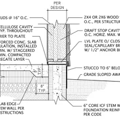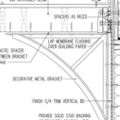Sub-slab condensate drain
This articlementions running a condensate drain for a mini-split to a leaching system under the slab, or tying it to the radon pipes. Is this a common/recommended technique? If tying to a DWV system risks leaking sewer gas through a dry trap, doesn’t this system have the same risk for radon?
–John
GBA Detail Library
A collection of one thousand construction details organized by climate and house part










Replies
Your concern makes sense to me. And this page implies that that is against code.
http://inspectapedia.com/aircond/Condensate_Drains.php
Vermont has little to no building code enforcement, so that explains why a builder might get into this habit without ever being challenged on code.
The suggested solutions on the page I linked share a trap with a sink or tub, and so don't have the problem that this was supposed to solve.
The radon pipe tie-in seems like an especially bad idea with a fan: if the fan is above where this ties in, the fan could pull conditioned air out through the drain; if there's a fan below where this ties in, the fan gets wet with condensate and blows radon into the house. It's a small hole, but why introduce a problem when there's an easy, code-approved solution?